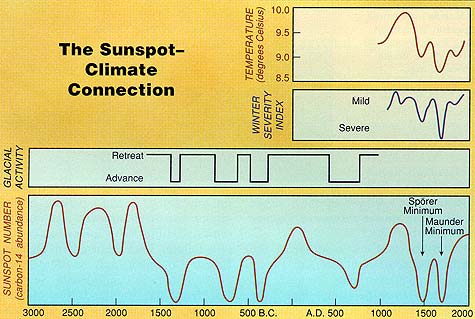The Little Ice Age
— Will there be another one?
Of course the Earth is warming up a little, and has been doing so since long before the
massive increase in industrialization that happened during the second half of the last
century. The Earth warmed up before and cooled off again, many times. Evidence
exists that shows that there were 17 or so Great Ice Ages. Lately the Earth has been
warming up a little, ever since we began our climb out of the Little Ice Age during the
19th century. The cooling trend that marked the beginning of the Little Ice Age
began around 1400, reached its peak during the 17th century and ended late in the 19th
century. Although it could well be said that we are still coming out of it, that
will most likely not be for much longer.

Source: Figure 8: Solar activity vs. date as related to
various phenomena.
(Original Source: Schaefer, 1997),
Determining the Climate
Record]
The reconstructed surface
temperature record for the Sargasso Sea reflects in almost perfect synchronicity the
variations in the solar radiation over time.
For a comprehensive collection references to studies of proxy climate
records throughout the world refer to
Medieval Warm Period Project, by CO2
Science
It is estimated that before the Little Ice Age began
around 1400, the sea surface around Iceland was about 4° C warmer than it is now,
enabling a man to make a long swim to the island of Hvalsey, off the coast of Iceland, to
rescue stranded sheep. It was a swim that nobody in their right mind would undertake
today because they would be dead of hypothermia in a short while after setting out,
without having a hope of coming even close to covering the distance.2
The time before the onset of the Little Ice Age was so warm that grapes and many other
crops could be grown in England that can now not be grown there, but they can still be
grown today 300 miles farther south, in France and in Germany.3
The time before the Little Ice Age was when the Viking settlements were thriving in
Greenland, while the onset of the Little Ice Age caused those colonies to perish.
The time of the Little Ice Age was a time of very low solar activity. Due to the
lull in solar activity then there were consequently no or only
low-intensity solar flares during that interval and also less solar radiation that hit the surface of the
Earth. In addition, the reduction in solar radiation and in the
intensity of the solar wind increased cosmic radiation that penetrated
the atmosphere, caused vast increases in condensation kernels, thereby
increasing the cloud cover. That caused the Earth to cool off. Now that we had a period of close to 100 years
during which solar activity increased (Fig. 2), the Earth
began to warm up a little even though annual mean temperatures are still a little below the average global
temperature for the last 3,000 years.
However, most likely the current warm spell won't last all that long. After all, if
we go by the downward trend in global temperatures during the past 3,000 years, it is
bound to get colder, much colder. Most likely the people are right who predict that
within about 30 years we'll enter another Little Ice Age and that maybe in about 600
years, give or take about 300 years, we'll be at risk of entering another Great Ice
Age, one of those that may last 90,000 years or so.
The climate is constantly
changing. Alternate cycles of long cold periods and much shorter
interglacial warm periods occur with some regularity. The typical
length of climatic cycles in the last 2 million years was about
100,000 years, divided into 90,000 years for Ice Age periods and
10,000 years for the warm, interglacial ones. Within a given cycle,
the difference in temperature between the cold and warm phases
equals 3°C to 7°C. The present warm phase is probably drawing to an
end—the average duration of such a phase has already been exceeded
by 500 years. Transition periods between cold and warm climate
phases are dramatically short: They last for only 50, 20, or even 1
to 2 years, and they appear with virtually no warning.
Source: "THE
ICE AGE IS COMING! Solar Cycles, Not CO2, Determine
Climate"
By Zbigniew Jaworowski, M.D., Ph.D., D.Sc.
21st CENTURY SCIENCE & TECHNOLOGY, Winter 2003-2004
The calculations done by General Circulation Models (GCMs) are
the main source of the information that fuels the global warming hysteria.
Nevertheless, not one of them comes acceptably close to accurately calculating
what the climate presently is at any location, let alone of the whole Earth.
Not only that, but all of the GCMs differ widely from one another as to what the
climate was in the past, and as to what it is supposed to be in the future.
Therein lies the problem. No one in his right mind will base any decisions
about the future on tools that cannot determine with acceptable accuracy what
the present is and the past was.
|



